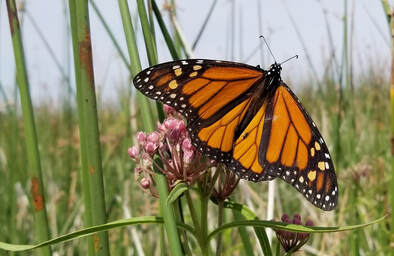 Monarch Butterfly Photo Credit: Xerces Society Monarch Butterfly Photo Credit: Xerces Society Monarchs (Danaus plexippus) are a butterfly species and an important pollinator throughout America and Mexico. Here in Nevada we have the Western Monarch. The monarch life cycle “metamorphosis” starts as an egg; they lay their eggs on milkweed plants. The egg hatches into a larva also known as a caterpillar they feed on the milkweed which contains cardiac glycosides. This is poisonous to birds and other animals but not the monarchs. The butterfly lara molts into a chrysalis; their body hardens and they enter the pupa stage (moth larvae construct cocoons an external structure to protect their pupa body), after almost a month in the chrysalis stage an adult monarch butterfly emerges. Because the adult butterfly ate milkweed as a larva they are poisonous to birds and other predatory animals. They are bright orange and black/brown with white spots the bright color warns off predators indicating they are poisonous. Monarchs migrate south in the winter and north in the summer, one generation goes south the next goes north and this migration pattern continues. Western Monarchs migration is currently threatened according to Xerces Society for invertebrate conservation “In both 2018 and 2019, volunteers counted under 30,000 monarchs—less than 1% of the population’s historic size.” A few reasons for the decline in monarch populations is due to loss of habitat, degradation of their habitats, pesticides, and climate change. The five key steps to recovering the western monarch population in the short term are from the Xerces Society for Invertebrate Conservation: 1. Protect and manage California overwintering sites 2. Restore breeding and migratory habitat in California 3. Protect monarchs and their habitat from pesticides 4. Protect, manage, and restore summer breeding and fall migration monarch habitat outside of California 5. Answer key research questions about how to best aid western monarch recovery
0 Comments
Leave a Reply. |
AuthorThis blog is managed by the staff and volunteers of Galena Creek Visitor Center. We write about parts of the natural world that we find fascinating and want to teach others about, as well as keeping you updated on the Visitor Center and park. If you want to learn more, please sign up for our monthly newsletter, where we share upcoming events, updates on the ecology of the park, and highlights from each month. Archives
October 2021
Categories |
 RSS Feed
RSS Feed
